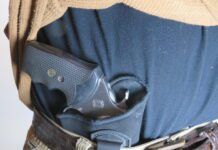Along with our experiences with the .32 Magnums, we also shot and evaluated two more ultralight .38 Special +P revolvers, which in our minds offer comfort on par with the .32s while shooting rounds most Gun Tests readers will recognize and prefer. Here’s what we thought of S&W’s seven-shot titanium Centennial 242 and the Taurus 85ULTi five-shot .38 Special +P.
Smith & Wesson 242
Our first experience with Smith & Wesson’s Centennial series was the little five-shot alloy Model 442. Perhaps the best hideout gun of all time, it featured a fine double-action-only trigger that seemed custom. The trigger pull was long but very smooth and could be halted with the firing pin ready to go. The same style of action comes with the 242, but we found it to be rough at best. The 442 is still available (now rated for +P) for about $400, which makes it one of the more expensive five-shooters. The seven-shot 242 actually sells for around $500, so it’s a deal when you consider the original 442 cost $80 per chamber. Nevertheless, we’d prefer to see a more refined action in the titanium 242.
As on titanium .44 Specials we tested last month, we noticed a drag just before the 242 let-off. As with the Taurus revolvers, this never shows up while dry-firing. This leads us to believe that it is either a headspace problem or a heat-expansion problem. The 242’s cylinder gap measured 0.007 inch, 0.002 inch larger than its .44 Special brother. Visually, the 242 is the same as the .44 Special save for the additional fluting on the cylinder. Headspace appears to be adequate, approximately 0.07 inch, a measurement shared the Smith & Wesson .44s and .38s. We tried shooting the 242 with one cylinder loaded at a time, then two, then three, etc. All we could say for sure was some of the cylinders loaded and unloaded with more difficulty than others. This may have caused sudden variations in headspace related to the ultralight weight of the gun versus the loaded rounds in the chambers shifting their position in response to recoil at a radically different rate than the surrounding gun. This spoiled some very impressive groups and threatens what could be a really nifty carry gun. We can think of hotter rounds with more aggressive projectiles than the ones we used for testing, but this might only serve to make matters worse. Companies like MagSafe, Cor-Bon, and Mullins are doing some terrific things with .38 Special +P these days.
Our recommendation: If the 242’s problems can be cured, it would have our highest endorsement. Until then, we’d have to pass on it.
Taurus 85ULTi
This five-shot .38 Special +P is perhaps Taurus’ best ultralight effort to date. In the March 1999 issue of Gun Tests we reviewed the Smith & Wesson 342Ti. It showed remarkable accuracy from the bench at 15 yards. We shot groups as small as 1 inch (1.9 inches on average) using Federal’s American Eagle 130-grain full-metal-jacket ammunition. The Taurus 85ULTi couldn’t match that but did achieve an average of 2.1 inches with a similar round, Winchester’s 130-grain FMJ.
The big difference is in shootability. The Smith was so light we had to swap grips with another gun so we could shoot it without help from a first-aid kit. The S&W 342Ti is certainly a super hideout gun, but the Taurus 85ULTi is just as concealable and is a ball to shoot. Remember the warning from Smith to only shoot jacketed ammo for fear of the crimp letting go? The Taurus is compensated, taking the edge off recoil and letting you shoot whatever bullet you have. This adds longevity to the gun, as jacketed bullets are much harder on the forcing cone than lead. Other design features on the Taurus that diminish recoil are a compact frame with a high grip that lowers the bore line in the hand. Also, this is a multi-alloy gun. By this Taurus means the frame is alloy, the cylinder and barrel shroud are titanium. The barrel itself (like the Smith 342Ti) is stainless steel, which adds weight at the muzzle. We encountered no jams or hesitation in the trigger pull throughout our test. Perhaps our theory about galling between the cylinder and the forcing cone as found on other Taurus models holds up.
Other features on the 85ULTi are a capped non-weight bearing ejector rod. Additional lock up is by way of spring loaded detent at the crane. The muted finish aids in the sight picture, as does the dark-colored front blade against the lighter-gray rear notch. The Taurus Security System is included. We like the fact that the 85ULTi offers single action.
The one flaw we found was a failure to fire due to insufficient hammer strike on two occasions out of 200+ rounds. This did not happen during rapid-fire drills or in single-action mode when trigger inertia is at its peak, but when aiming carefully using a deliberate double-action press. For general consumption, we feel Taurus should consider the use of a heavier mainspring. Another solution would be to hand load using a primer with a softer cup, such as the Federal number 100 for small pistol.
Our recommendation: Of the lightest guns we’ve shot, the Taurus 85ULTi is the only gun we’d like to shoot often, and that’s the way it should be for a gun carried for self-defense. Buy it.






























